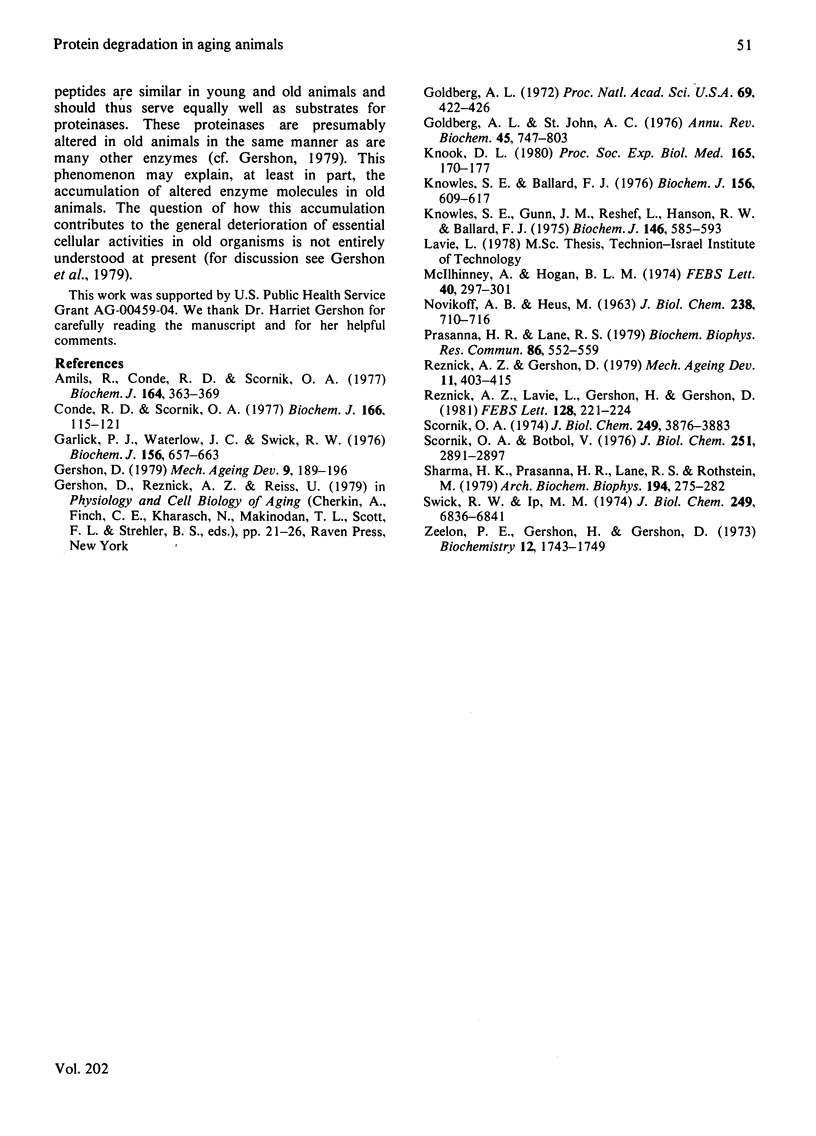Abstract
Liver protein-degradation rates were determined in young and old C57B1 mice by the method of Swick & Ip [(1974) J. Biol. Chem. 249, 6836-6841]. The results indicated a marked age-related increase in the half-lives of short-lived proteins in the nuclear, mitochondrial, lysosomal and 100000 g-supernatant cellular fractions and in total trichloroacetic acid-precipitable proteins. The efficiency of the degradation system in removing aberrant proteins from livers of young and old mice was tested. The time required for 50% disappearance of puromycinyl-peptides changed from about 20 min in 6-month-old mice to approx. 150 min in 24-month-old animals. These findings suggest that in old animals the proteolytic activity involved in degradation of aberrant proteins, and presumably of "native proteins, is markedly defective.
Full text
PDF




Selected References
These references are in PubMed. This may not be the complete list of references from this article.
- Amils R., Conde R. D., Scornik O. A. Effect of a nutritional shift on the degradation of abnormal proteins in the mouse liver. Decreased degradation during rapid liver growth. Biochem J. 1977 May 15;164(2):363–369. doi: 10.1042/bj1640363. [DOI] [PMC free article] [PubMed] [Google Scholar]
- Conde R. D., Scornik O. A. Faster synthesis and slower degradation of liver protein during developmental growth. Biochem J. 1977 Jul 15;166(1):115–121. doi: 10.1042/bj1660115. [DOI] [PMC free article] [PubMed] [Google Scholar]
- Garlick P. J., Waterlow J. C., Swick R. W. Measurement of protein turnover in rat liver. Analysis of the complex curve for decay of label in a mixture of proteins. Biochem J. 1976 Jun 15;156(3):657–663. doi: 10.1042/bj1560657. [DOI] [PMC free article] [PubMed] [Google Scholar]
- Gershon D. Current status of age altered enzymes: alternative mechanisms. Mech Ageing Dev. 1979 Feb;9(3-4):189–196. doi: 10.1016/0047-6374(79)90098-8. [DOI] [PubMed] [Google Scholar]
- Goldberg A. L. Degradation of abnormal proteins in Escherichia coli (protein breakdown-protein structure-mistranslation-amino acid analogs-puromycin). Proc Natl Acad Sci U S A. 1972 Feb;69(2):422–426. doi: 10.1073/pnas.69.2.422. [DOI] [PMC free article] [PubMed] [Google Scholar]
- Goldberg A. L., St John A. C. Intracellular protein degradation in mammalian and bacterial cells: Part 2. Annu Rev Biochem. 1976;45:747–803. doi: 10.1146/annurev.bi.45.070176.003531. [DOI] [PubMed] [Google Scholar]
- Knook D. L. The isolated hepatocyte: a cellular model for aging studies. Proc Soc Exp Biol Med. 1980 Nov;165(2):170–177. doi: 10.3181/00379727-165-40954. [DOI] [PubMed] [Google Scholar]
- Knowles S. E., Ballard F. J. Selective control of the degradation of normal and aberrant proteins in Reuber H35 hepatoma cells. Biochem J. 1976 Jun 15;156(3):609–617. doi: 10.1042/bj1560609. [DOI] [PMC free article] [PubMed] [Google Scholar]
- Knowles S. E., Gunn J. M., Reshef L., Hanson R. W., Ballard F. J. Properties of phosphoenolpyruvate carboxykinase (guanosine triphosphate) synthesized in hepatoma cells in the presence of amino acid analogues. Biochem J. 1975 Mar;146(3):585–593. doi: 10.1042/bj1460585. [DOI] [PMC free article] [PubMed] [Google Scholar]
- McIlhinney A., Hogan B. L. Rapid degradation of puromycyl peptides in hepatoma cells and reticulocytes. FEBS Lett. 1974 Apr 1;40(2):297–301. doi: 10.1016/0014-5793(74)80248-6. [DOI] [PubMed] [Google Scholar]
- NOVIKOFF A. B., HEUS M. A microsomal nucleoside diphosphatase. J Biol Chem. 1963 Feb;238:710–716. [PubMed] [Google Scholar]
- Prasanna H. R., Lane R. S. Protein degradation in aged nematodes (Turbatrix aceti). Biochem Biophys Res Commun. 1979 Feb 14;86(3):552–559. doi: 10.1016/0006-291x(79)91749-2. [DOI] [PubMed] [Google Scholar]
- Reznick A. Z., Gershon D. The effect of age on the protein degradation system in the nematode Turbatrix aceti. Mech Ageing Dev. 1979 Dec;11(5-6):403–415. doi: 10.1016/0047-6374(79)90016-2. [DOI] [PubMed] [Google Scholar]
- Reznick A. Z., Lavie L., Gershon H. E., Gershon D. Age-associated accumulation of altered FDP aldolase B in mice. Conditions of detection and determination of aldolase half life in young and old animals. FEBS Lett. 1981 Jun 15;128(2):221–224. doi: 10.1016/0014-5793(81)80085-3. [DOI] [PubMed] [Google Scholar]
- Scornik O. A., Botbol V. Role of changes in protein degradation in the growth of regenerating livers. J Biol Chem. 1976 May 25;251(10):2891–2897. [PubMed] [Google Scholar]
- Scornik O. A. In vivo rate of translation by ribosomes of normal and regenerating liver. J Biol Chem. 1974 Jun 25;249(12):3876–3883. [PubMed] [Google Scholar]
- Sharma H. K., Prasanna H. R., Lane R. S., Rothstein M. The effect of age on enolase turnover in the free-living nematode, Turbatrix aceti. Arch Biochem Biophys. 1979 Apr 15;194(1):275–282. doi: 10.1016/0003-9861(79)90619-2. [DOI] [PubMed] [Google Scholar]
- Swick R. W., Ip M. M. Measurement of protein turnover in rat liver with (14C)carbonate. Protein turnover during liver regeneration. J Biol Chem. 1974 Nov 10;249(21):6836–6841. [PubMed] [Google Scholar]
- Zeelon P., Gershon H., Gershon D. Inactive enzyme molecules in aging organisms. Nematode fructose-1,6-diphosphate aldolase. Biochemistry. 1973 Apr 24;12(9):1743–1750. doi: 10.1021/bi00733a013. [DOI] [PubMed] [Google Scholar]


